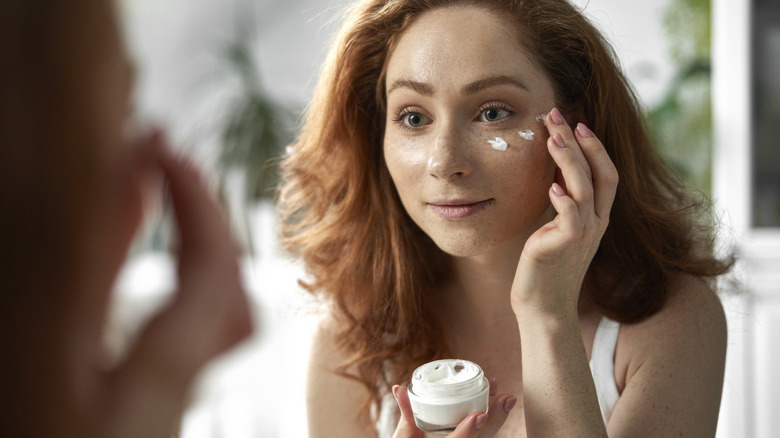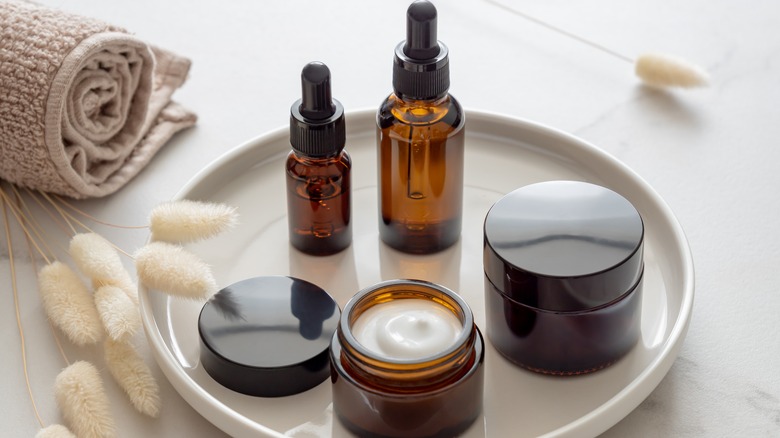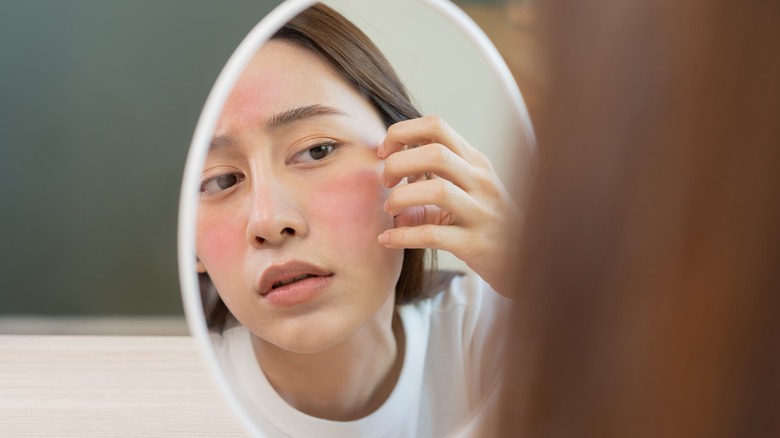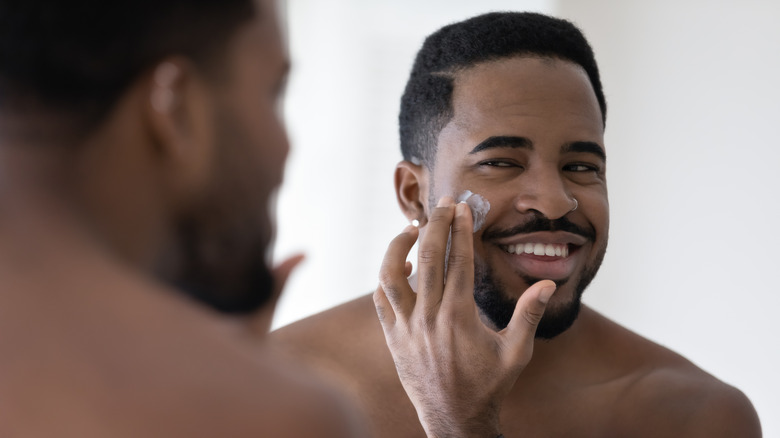The Rules To Follow When Introducing A New Product To Your Skincare Routine
Switching up your skincare routine can come about for a number of reasons, ranging from your dermatologist's recommendation to your own desire to skin stream your skincare regimen or simply to try out a new product. A number of factors can lead to the need for an additional product to be added to your skincare routine, which is step one in the process of building onto your established system.
The next step is introducing the new product in a way that is healthy and safe for your skin, so being informed is key. Building a skincare system that works for you is an accomplishment in the first place, let alone adding in new products as you go along. Always be patient with yourself and kind to your skin as skincare is a process that takes time for results.
Good Housekeeping reveals that the three primary layers of any skincare composition should emphasize cleansing the skin, treating respective concerns, and moisturizing to avoid the skin becoming too dry. Within those three layers are numerous types of cleansers, serums, ointments, gels, lotions, and a plethora of other items to choose from. However, this doesn't exactly make things feel simple when you walk down the skincare aisle or shop online for products. Whether you already have an established skincare routine, or if you're just getting started, here are some straightforward tips for adding in new products without feeling overwhelmed by the process. Of course, always consult with a dermatologist if you have specific concerns about your skin.
Know why you're introducing the new product
Before you purchase a new skincare product for your daily skincare schedule, you should first understand: why the product should be added to your routine; if it should be used both morning and night; and if it contains the correct ingredients for your skincare needs. Curating a skincare routine that works for you depends very much on your skin type and your unique skincare needs, though there are many other components taken into account when building an individualized skincare routine, reports Yahoo.
For the most part, there are four categories of skincare needs that are commonly treated by over-the-counter products. Those categories are oily skin, dry skin, sensitive skin, and combination skin. Other common concerns treated by respective skincare products include acne, dark spots, hyperpigmentation, fine lines, wrinkles, acne scarring, and skin that is excessively oily or dry. Determining which category your skincare needs fall into is extremely important as you don't want to apply products that will work against your needs, potentially exacerbating issues or creating new problems.
As for other factors to examine when deciding on whether or not to introduce a new product into your skincare routine, you'll want to take into consideration age-related changes in your skin, potential hormonal changes, and even the weather in your local area, particularly as the seasons and outdoor temperatures change, advises Self. Take note of your exposure to sunlight, indoor heating systems, and humidity as you make changes to your regimen.
Be aware of ingredients that shouldn't be combined
One thing to be mindful of when choosing skincare products is that your skin absorbs topical products, in turn absorbing ingredients into your body. You'll want to make certain you know what's in your skincare products so you can remain informed about what your body is taking in and absorbing.
Another reason to know the ingredients in skincare products is that many common ingredients in cosmetics, both prescription and over-the-counter, don't mesh well and some combinations can have detrimental effects on the skin. Everyday Health reports that knowing how different mixtures react with one another is critical information to be aware of because some ingredients make one another ineffective when they're combined, while others can lead to serious side effects, such as extreme sensitivity to sun exposure, excessive dryness and peeling, and allergic reactions.
Before introducing a new product, make certain that it doesn't share active ingredients with any of your existing skincare products that are used concurrently. Knowing the combinations of active ingredients to avoid is vital education to have under your belt before adding a new product. The most notable combinations to avoid include vitamin C with soap-based products and cleansers, vitamin C with niacinamide, and any product with SPF in it mixed with a moisturizer or makeup product. Retinoids and retinol, which include prescription tretinoin and products high in vitamin A, should never be combined with the simultaneous use of benzoyl peroxide, vitamin C, glycolic acid, or salicylic acid.
Don't rush the introduction of a new product
Never rush into introducing a new product, especially those with ingredients like retinoids and skin exfoliants like glycolic acid, so that you can closely monitor any potential side effects that may arise and be aware of how your skin is reacting to the new product, recommends Self. If your dermatologist is advising you on the use of a new item in your regimen, then you'll want to be certain to follow their instructions for how to pace the process of introducing it to your skin. You'll also want to know which side effects to be on the lookout for. As a rule of thumb, you'll likely start by using the product once per week; then move up to every other day; and, ultimately, incorporate it on a daily basis if that's the intended plan for your use of the product.
Whether you're using prescription-based medicated treatments or over-the-counter commodity units, keep an eye out for side effects such as redness, irritation, drying of the skin, and signs of an allergy to the new ingredients, states WebMD. Severe reactions to skincare or cosmetic products can produce sensations of burning, itching, swelling, and even hives or blisters that may form into pustules that can ooze or bleed if scratched, which in turn can leave skin raw and at risk of further harm from contact dermatitis and UV rays. If any of these side effects occur, stop using the new product immediately and consult with your healthcare provider.
Practice patience as the product takes effect
After you've established that the new product you anticipate adding to your skincare routine isn't in direct conflict with any existing products and if you haven't noticed any signs of harmful side effects to your skin, the next step is patience. Remember to never begin using a new product on a daily basis unless directed by your healthcare provider. As you advance from weekly application up to daily use (if applicable for the product), patience will be your best friend during the process. Self reports that most skincare products take time to generate noticeable results, with products like vitamin C taking up to three months to begin showing positive effects and some products taking up to six months or longer.
You may also notice a phenomenon called "skin purging," which occurs when skin conditions worsen temporarily before long-term positive impacts of the product or ingredient being introduced begin to transpire, according to Health. Skin purging frequently happens when treating acne and blemishes, with the most common culprits of skin purging being vitamin C, retinoids and retinol, and some cleansers. As skin purging occurs, you may feel frustrated and want to discontinue the product; but keep the faith that you'll see results in due time. If you're concerned about the trajectory of your skincare journey, speaking with a dermatologist can provide you with additional education about how your unique skin is reacting to the various products and ingredients in your skincare regimen.
Self-care is an important component of skincare
As you incorporate a new product into your skincare system and wait for results to appear, another core component of making the process as seamless as possible is practicing self-care. It may not seem like self-care is directly correlated with skin health, especially regarding the introduction of a new product, but there are relational components between regular self-care and improvements in skin health that can help you see positive results sooner.
Everyday Health reveals several ways that practicing self-care, utilizing mindfulness and meditation, and taking care of your holistic wellness can lead to overall healthier skin, including fewer breakouts. The less stress you experience, the more you'll decrease your chances of stress-related acne breakouts, which is where meditation can play a role in creating clearer skin since regular meditation, even if just for a few minutes each day, can significantly reduce stress levels.
Meditation and other mindfulness habits, such as expressing gratitude and establishing intentional awareness in the present moment, can help you cope with any correlating anxiety or stress over potential skin purging you might experience as you introduce a new product into your skincare regimen. Mindfulness can be beneficial for decreasing any frustration you might experience over having to wait for the new skincare ingredient to positively affect your skin. Be kind to yourself and remember that it's completely normal to feel frustration or exasperation as you wait to see long-awaited results on your skin.
Stay hydrated and prioritize sleep quality
Expanding upon self-care and skin health, there are additional wellness strategies that can help speed along the process of assisting the new product in your skincare routine with producing the desired results. Two of the most important elements of boosting your skin's well-being, simultaneously decreasing stress levels and aiding in beneficial influences to other aspects of your physical and mental health, are drinking sufficient amounts of water each day and getting the recommended amount of sleep each night.
Drinking plenty of water on a daily basis can reduce the appearance of pores, blemishes, and even fine lines as water replenishes skin's hydration and increases its elasticity, per Forefront Dermatology. If you don't drink enough water throughout the day, your pores can appear larger and more visible, while your skin can look dull, dry, and tired.
Sleep is equally as important as drinking water, perhaps even slightly more beneficial in aiding in the effectiveness of your new skincare product since being well-rested can reduce stress levels and anxiety and provide your body with ample time to become rejuvenated and refreshed. A 2015 study published in JAMA Internal Medicine found a full-circle correlation between mindfulness, meditation, sleep quality, and complexion. Researchers determined that participants who practiced regular meditation achieved better overnight sleep quality, producing better overall health outcomes. Everyday Health emphasizes the importance of how sleep quality, including responsible sleep hygiene, can reduce skin concerns like blemishes and dark spots while improving general appearance.
Skin protection is a steadfast rule
Adequate sleep, water consumption, and stress reduction can result in skin appearing brighter. This is especially beneficial if you're waiting for a product containing vitamin C to create brightening effects since it's an ingredient that can take several months to produce results.
As your skin becomes brighter, you're likely to develop a healthy, vibrant glow. Be wary that you don't begin glowing red from sunburn, though. While introducing a new ingredient to your skin, perhaps the most steadfast rule is always wearing sunscreen, shares The Healthy. Common skincare ingredients like retinoids, benzoyl peroxide, and glycolic acid can increase sensitivity to UV rays and sun exposure, making it imperative to apply sunscreen daily, even on days when you don't plan on going outside. Sunburns can lead to skin developing blisters, oozing, peeling, and the deeper layers of skin becoming raw and exposed, thus putting your body at risk of bacteria entering and instigating a possible infection. You'll want to leave post-it notes or virtual reminders on your phone to apply sunscreen. This is especially pertinent if you're introducing a new skincare product involving an ingredient that increases your risk of developing a sunburn. Even after you've established the new ingredient as a regular component of your skincare regimen, you'll want to continue using sunscreen regularly. Since many sunscreens can produce oily effects on the skin, you may consider looking for a non-greasy option to avoid additional breakouts on your skin; but always apply sunscreen!







